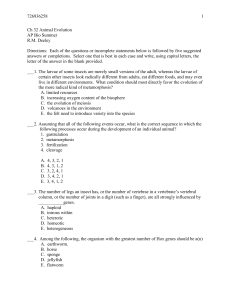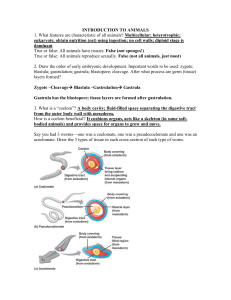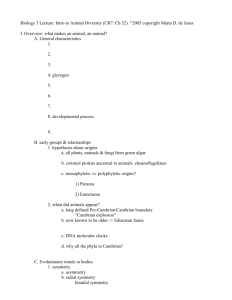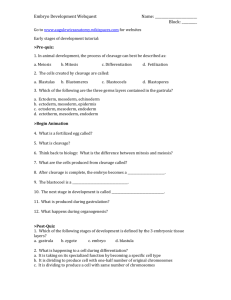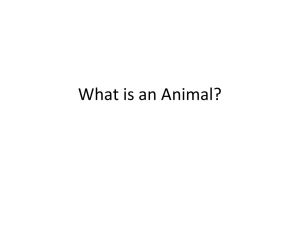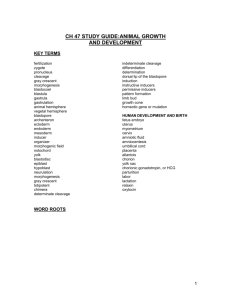Document
advertisement
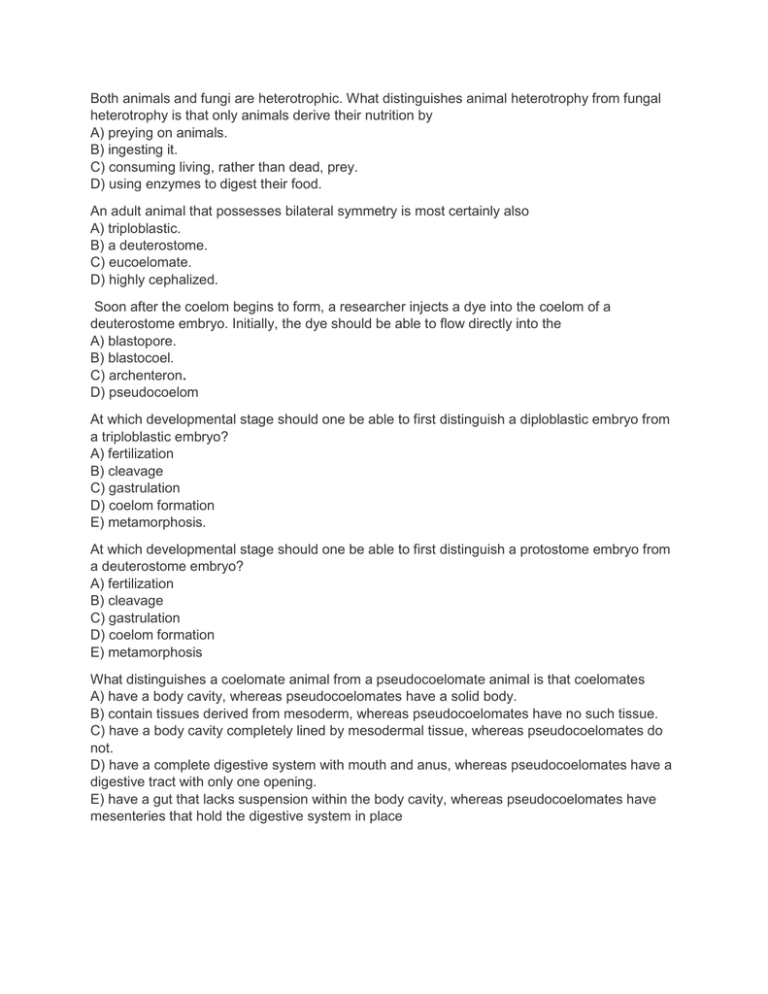
Both animals and fungi are heterotrophic. What distinguishes animal heterotrophy from fungal heterotrophy is that only animals derive their nutrition by A) preying on animals. B) ingesting it. C) consuming living, rather than dead, prey. D) using enzymes to digest their food. An adult animal that possesses bilateral symmetry is most certainly also A) triploblastic. B) a deuterostome. C) eucoelomate. D) highly cephalized. Soon after the coelom begins to form, a researcher injects a dye into the coelom of a deuterostome embryo. Initially, the dye should be able to flow directly into the A) blastopore. B) blastocoel. C) archenteron. D) pseudocoelom At which developmental stage should one be able to first distinguish a diploblastic embryo from a triploblastic embryo? A) fertilization B) cleavage C) gastrulation D) coelom formation E) metamorphosis. At which developmental stage should one be able to first distinguish a protostome embryo from a deuterostome embryo? A) fertilization B) cleavage C) gastrulation D) coelom formation E) metamorphosis What distinguishes a coelomate animal from a pseudocoelomate animal is that coelomates A) have a body cavity, whereas pseudocoelomates have a solid body. B) contain tissues derived from mesoderm, whereas pseudocoelomates have no such tissue. C) have a body cavity completely lined by mesodermal tissue, whereas pseudocoelomates do not. D) have a complete digestive system with mouth and anus, whereas pseudocoelomates have a digestive tract with only one opening. E) have a gut that lacks suspension within the body cavity, whereas pseudocoelomates have mesenteries that hold the digestive system in place The blastopore is a structure that first becomes evident during A) fertilization. B) gastrulation. C) the eight-cell stage of the embryo. D) coelom formation. E) cleavage The blastopore denotes the presence of an endoderm-lined cavity in the developing embryo, a cavity that is known as the A) archenteron. B) blastula. C) coelom. D) germ layer. E) blastocoel. Which of the following is descriptive of protostomes? A) spiral and indeterminate cleavage, blastopore becomes mouth B) spiral and determinate cleavage, blastopore becomes mouth C) spiral and determinate cleavage, blastopore becomes anus D) radial and determinate cleavage, blastopore becomes anus E) radial and determinate cleavage, blastopore becomes mouth Sponges are most accurately described as A) marine predators. B) marine filter feeders. C) freshwater scavengers. D) aquatic filter feeders. E) aquatic predators. How many of the following are characteristics of at least some members of the phylum Cnidaria? 1. a gastrovascular cavity 2. a polyp stage 3. a medusa stage 4. cnidocytes 5. a pseudocoelom A) one of these B) two of these C) three of these D) four of these E) five of these Which of the following is true of members of the phylum Cnidaria? A) They are not capable of locomotion because they lack true muscle tissue. B) They are primarily filter feeders. C) They have either, or both, of two body forms: mobile polyps and sessile medusae. D) They may use a gastrovascular cavity as a hydrostatic skeleton. E) They are the simplest organisms with a complete alimentary canal (two openings)
